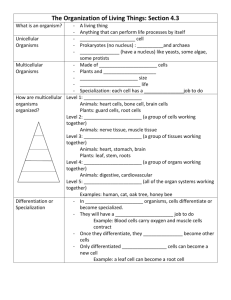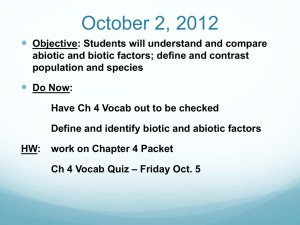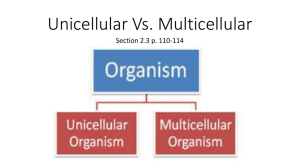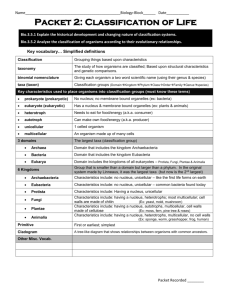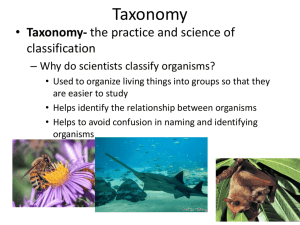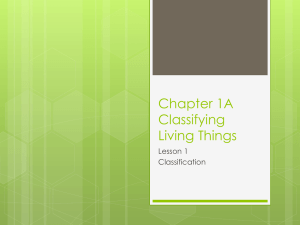Standard Biology Chapter 3 Classification
advertisement
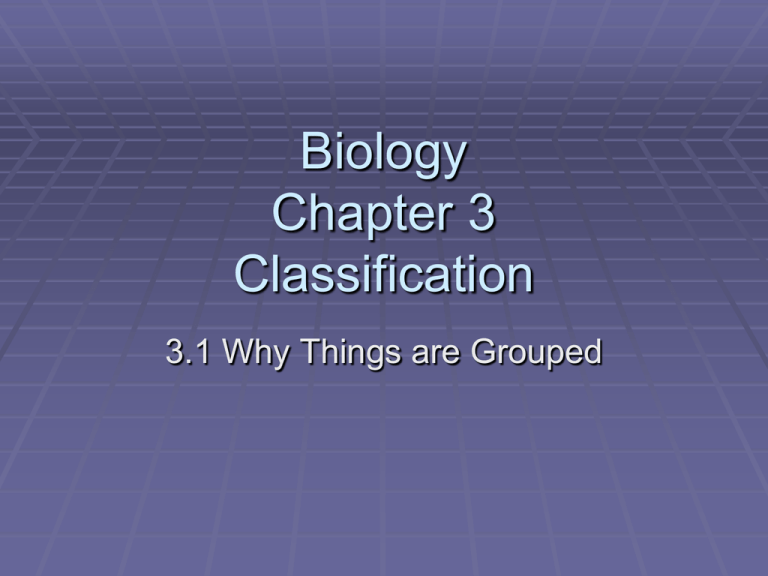
Biology Chapter 3 Classification 3.1 Why Things are Grouped Why Things are Grouped Classify: group things together based on similarities Classifying in Everyday Life What things do we classify? How Grouping Helps Us Easier to find Share traits (feature that a thing has) Faster Biology Chapter 3 Classification 3.2 Methods of Classification Early Classification Aristotle (Greek, lived about 2000 years ago) First to classify living things All living thing into two groups Plants herbs- small, soft stems shrubs- medium size, many trunks trees- tall, one trunk Animals live in water live on land live in air Problems with this plan some living things fit into more than one group some living things change groups as they grow and develop Used until 1700’s The Beginnings of Modern Classification Carolus Linnaeus (Swedish, 1735) Classified plants and animals into more groups Based system on specific traits Gave name to organisms that described their trait2 part name Seven Classification Groups kingdom- king phylum- Phillip class- came order- over familygenusspecies- from Germany swimming Two word names are genus and species People are Homo sapiens Biology Chapter 3 Classification 3.3 How Scientists Classify Things Classify Based on How Organisms Are Related The more closely related organisms are the more groups they share Compare cat, lion, deer, and octopus Tables 3-2 through 3-5 p. 56-57 Classification Chart Kingdom: Phylum: Class: Order: Family: Genus: Species: House Cat Animalia Chordata Mammalia Carnivora Felidae Felis Felis catus Dog Animalia Chordata Mammalia Carnivora Canidae Canis Canis familiaris Other Evidence Used in Classifying Evolutionary history The ancestors that organisms share Similar body structures Other Evidence Used in Classifying Body Chemistry How similar are proteins (blood) How similar is DNA (DNA fingerprinting) Scientific Names Came From Classification Scientific namesGenus species Designed by Linnaeus Genus- always capitalized species- always lower case In Latin so italics or underline Scientific Names Came From Classification Sometimes scientific names sound like common names Gorilla gorilla Giraffa camelopadalis Why Scientific Names Are Used No mistakes Common names occur for more than one type of organism, hawks Fig. 3-9 p. 60 Scientific names seldom change Scientific names are written in the same language (Latin) Classification of Kingdoms Two kingdoms- Aristotle and Linnaeus had plants and animals Then 3 kingdoms- plants, animals, and protists Then 5 kingdoms, plants, animals, protists, fungi, and monerans (bacteria) Now 6 kingdoms (started in 2000, not in your textbook) Archaebacteria (formerly Moneran) Live in extreme environments- hot, salt No nucleus or other cell parts One celled Unique cell wall and membrane Unique cell processes Eubacteria (formerly Moneran) No nucleus or other cell parts One celled More common bacteria Live in many places Protists Mostly one celled, some are many celled Nucleus and other cell parts Some like plants (algae: producers) Some like animals (protozoans: consumers) Some like fungi (decomposers) Fungi Have nucleus and other cell parts Multicellular except yeast Have cell walls Decomposers (absorb food) Plants Nucleus and other cell parts Multicellular Have chlorophyll for photosynthesis Have cell wall (don’t move) Animals Nucleus and other cell parts Multicellular Eat- consumers Move from place to place Classification Changes Classification changes as we learn more about organisms and their relationship to each other.
